Innovation and Commercialisation Report: Analysis of F-drones Business
VerifiedAdded on 2023/01/05
|17
|4078
|86
Report
AI Summary
This report provides an in-depth analysis of innovation and commercialisation, using F-drones as a case study. It begins by defining innovation, differentiating it from invention, and highlighting its importance to organizations. The report then explores how organizational vision, leadership, culture, and teamwork shape innovation and commercialisation. It delves into the 4Ps of innovation (product, process, position, and paradigm) and the innovation funnel, followed by an examination of frugal innovation. The report further examines the commercial funnel, the use of New Product Development (NPD), and the development and protection of intellectual property. The analysis includes a discussion of F-drones' innovative approach to aerial deliveries and its impact on the business. The report offers insights into how companies can foster innovation and successfully commercialize their ideas in a competitive market.
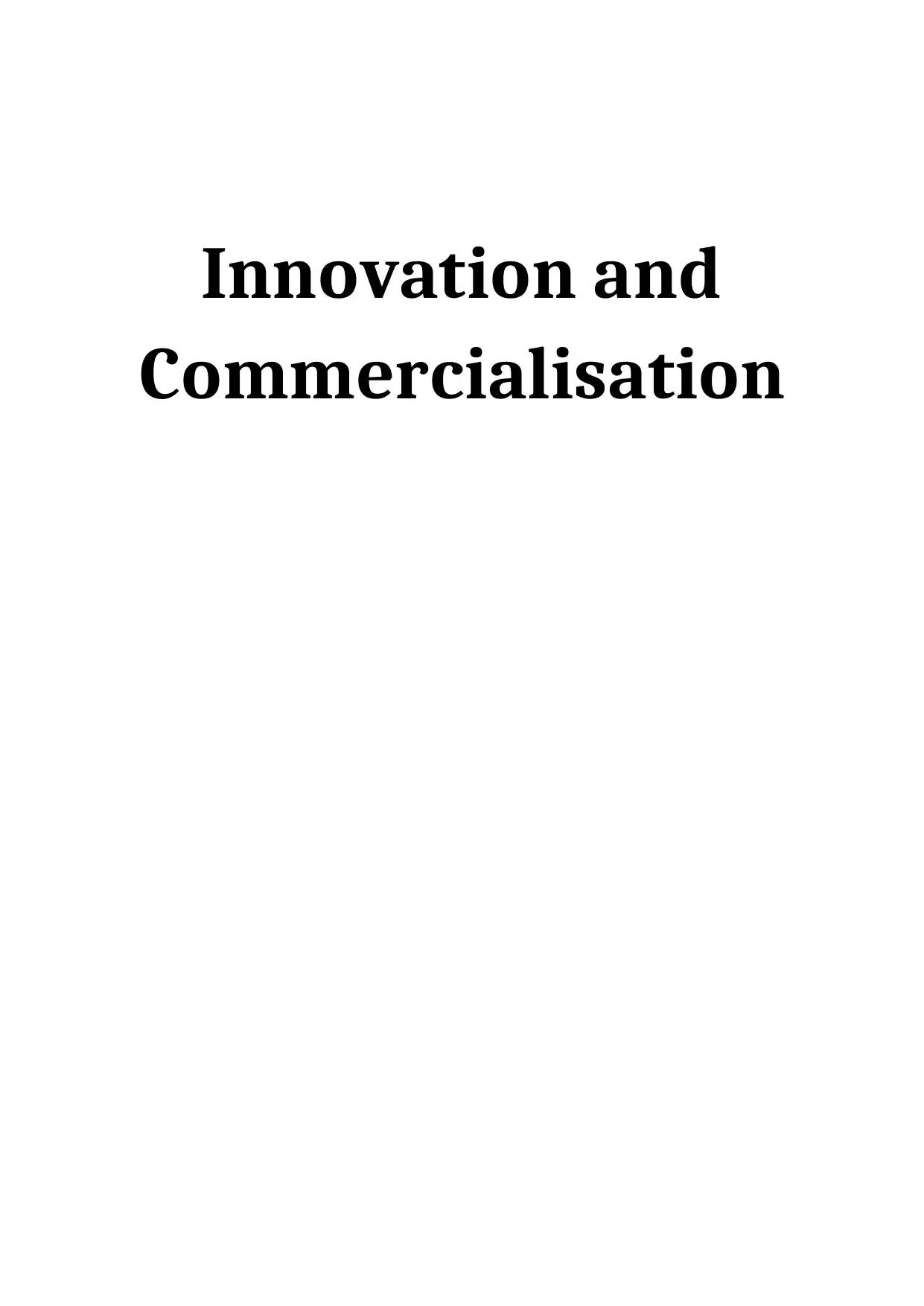
Innovation and
Commercialisation
Commercialisation
Paraphrase This Document
Need a fresh take? Get an instant paraphrase of this document with our AI Paraphraser
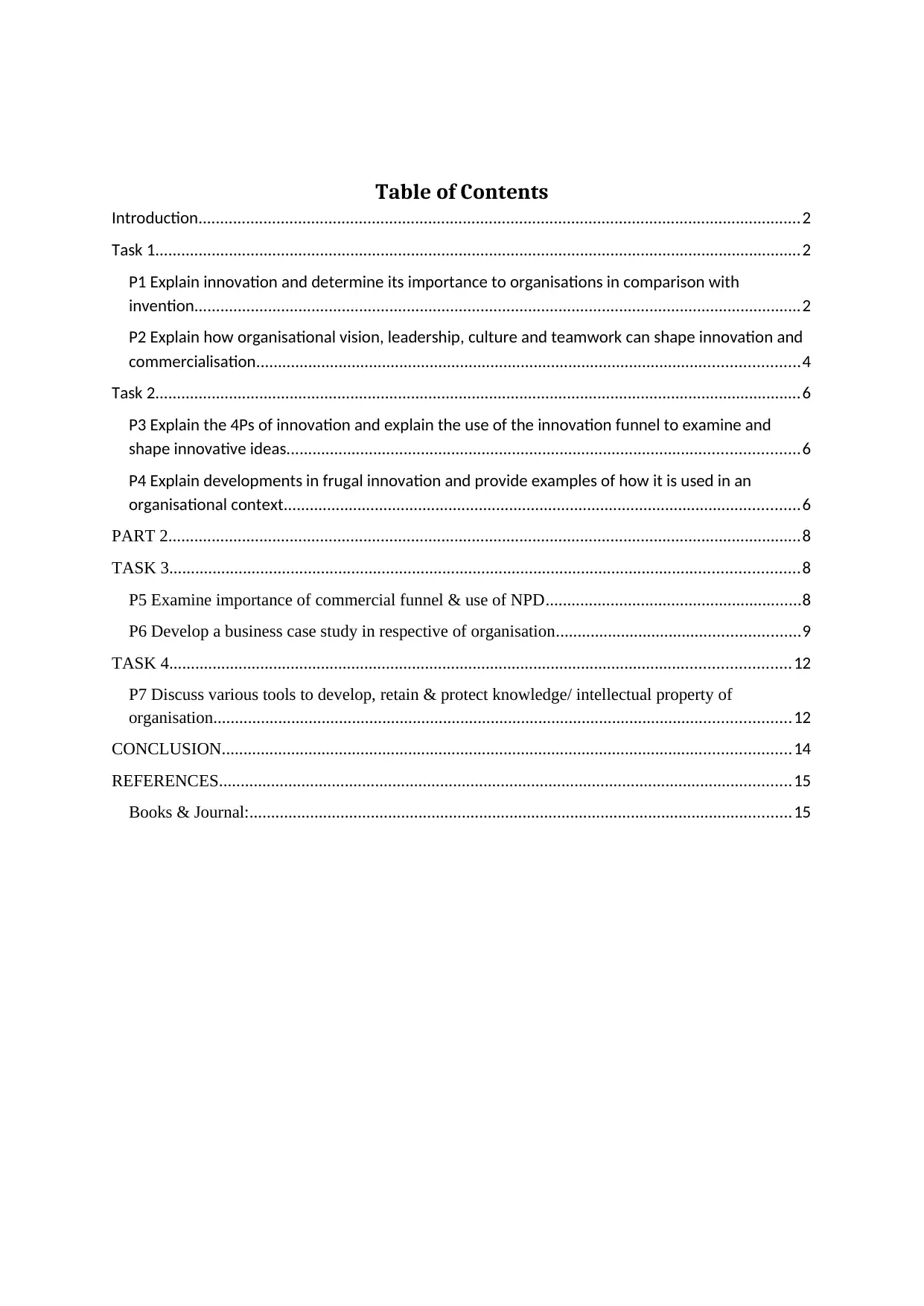
Table of Contents
Introduction...........................................................................................................................................2
Task 1.....................................................................................................................................................2
P1 Explain innovation and determine its importance to organisations in comparison with
invention............................................................................................................................................2
P2 Explain how organisational vision, leadership, culture and teamwork can shape innovation and
commercialisation.............................................................................................................................4
Task 2.....................................................................................................................................................6
P3 Explain the 4Ps of innovation and explain the use of the innovation funnel to examine and
shape innovative ideas......................................................................................................................6
P4 Explain developments in frugal innovation and provide examples of how it is used in an
organisational context.......................................................................................................................6
PART 2..................................................................................................................................................8
TASK 3.................................................................................................................................................8
P5 Examine importance of commercial funnel & use of NPD...........................................................8
P6 Develop a business case study in respective of organisation........................................................9
TASK 4...............................................................................................................................................12
P7 Discuss various tools to develop, retain & protect knowledge/ intellectual property of
organisation.....................................................................................................................................12
CONCLUSION...................................................................................................................................14
REFERENCES....................................................................................................................................15
Books & Journal:.............................................................................................................................15
Introduction...........................................................................................................................................2
Task 1.....................................................................................................................................................2
P1 Explain innovation and determine its importance to organisations in comparison with
invention............................................................................................................................................2
P2 Explain how organisational vision, leadership, culture and teamwork can shape innovation and
commercialisation.............................................................................................................................4
Task 2.....................................................................................................................................................6
P3 Explain the 4Ps of innovation and explain the use of the innovation funnel to examine and
shape innovative ideas......................................................................................................................6
P4 Explain developments in frugal innovation and provide examples of how it is used in an
organisational context.......................................................................................................................6
PART 2..................................................................................................................................................8
TASK 3.................................................................................................................................................8
P5 Examine importance of commercial funnel & use of NPD...........................................................8
P6 Develop a business case study in respective of organisation........................................................9
TASK 4...............................................................................................................................................12
P7 Discuss various tools to develop, retain & protect knowledge/ intellectual property of
organisation.....................................................................................................................................12
CONCLUSION...................................................................................................................................14
REFERENCES....................................................................................................................................15
Books & Journal:.............................................................................................................................15
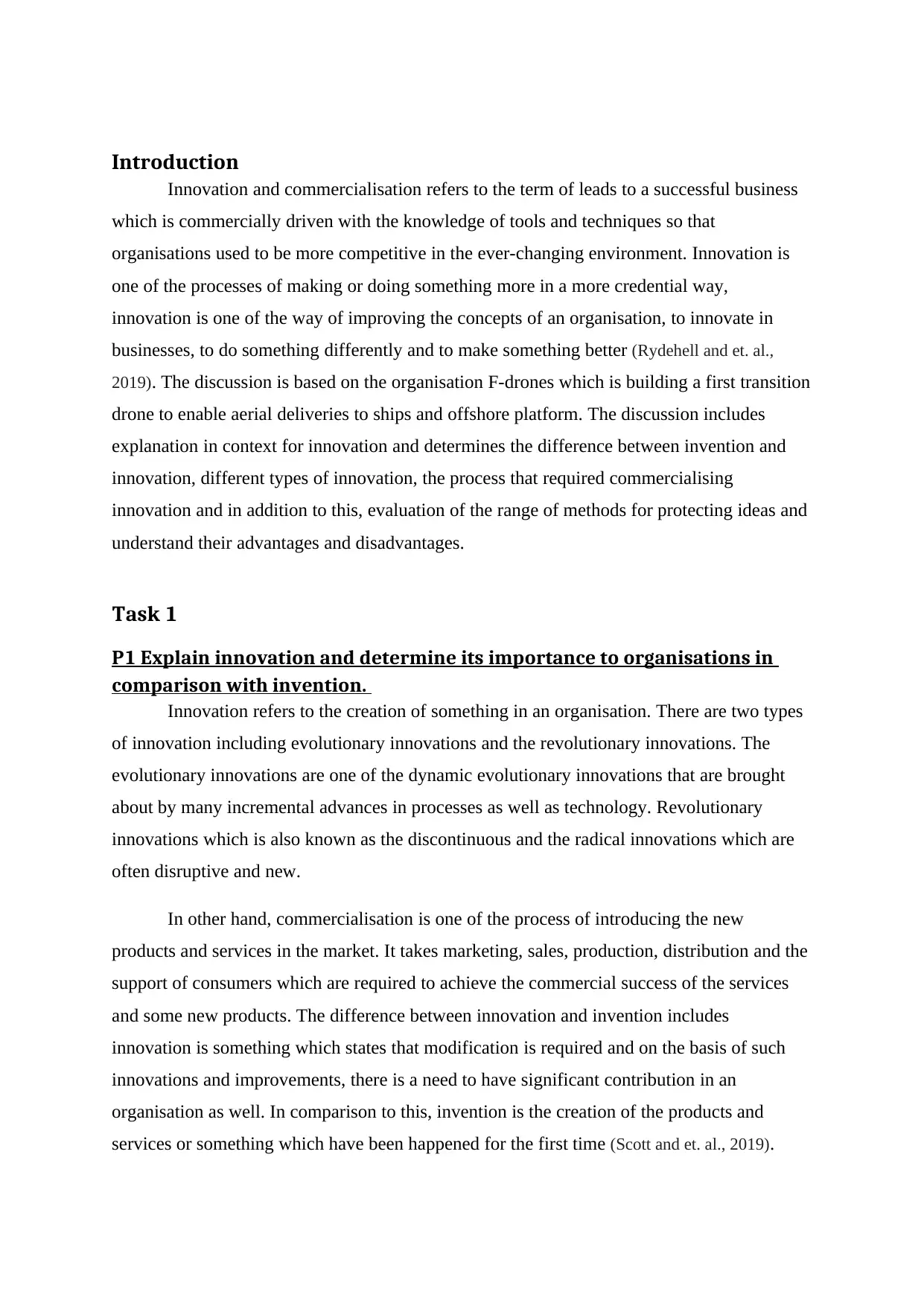
Introduction
Innovation and commercialisation refers to the term of leads to a successful business
which is commercially driven with the knowledge of tools and techniques so that
organisations used to be more competitive in the ever-changing environment. Innovation is
one of the processes of making or doing something more in a more credential way,
innovation is one of the way of improving the concepts of an organisation, to innovate in
businesses, to do something differently and to make something better (Rydehell and et. al.,
2019). The discussion is based on the organisation F-drones which is building a first transition
drone to enable aerial deliveries to ships and offshore platform. The discussion includes
explanation in context for innovation and determines the difference between invention and
innovation, different types of innovation, the process that required commercialising
innovation and in addition to this, evaluation of the range of methods for protecting ideas and
understand their advantages and disadvantages.
Task 1
P1 Explain innovation and determine its importance to organisations in
comparison with invention.
Innovation refers to the creation of something in an organisation. There are two types
of innovation including evolutionary innovations and the revolutionary innovations. The
evolutionary innovations are one of the dynamic evolutionary innovations that are brought
about by many incremental advances in processes as well as technology. Revolutionary
innovations which is also known as the discontinuous and the radical innovations which are
often disruptive and new.
In other hand, commercialisation is one of the process of introducing the new
products and services in the market. It takes marketing, sales, production, distribution and the
support of consumers which are required to achieve the commercial success of the services
and some new products. The difference between innovation and invention includes
innovation is something which states that modification is required and on the basis of such
innovations and improvements, there is a need to have significant contribution in an
organisation as well. In comparison to this, invention is the creation of the products and
services or something which have been happened for the first time (Scott and et. al., 2019).
Innovation and commercialisation refers to the term of leads to a successful business
which is commercially driven with the knowledge of tools and techniques so that
organisations used to be more competitive in the ever-changing environment. Innovation is
one of the processes of making or doing something more in a more credential way,
innovation is one of the way of improving the concepts of an organisation, to innovate in
businesses, to do something differently and to make something better (Rydehell and et. al.,
2019). The discussion is based on the organisation F-drones which is building a first transition
drone to enable aerial deliveries to ships and offshore platform. The discussion includes
explanation in context for innovation and determines the difference between invention and
innovation, different types of innovation, the process that required commercialising
innovation and in addition to this, evaluation of the range of methods for protecting ideas and
understand their advantages and disadvantages.
Task 1
P1 Explain innovation and determine its importance to organisations in
comparison with invention.
Innovation refers to the creation of something in an organisation. There are two types
of innovation including evolutionary innovations and the revolutionary innovations. The
evolutionary innovations are one of the dynamic evolutionary innovations that are brought
about by many incremental advances in processes as well as technology. Revolutionary
innovations which is also known as the discontinuous and the radical innovations which are
often disruptive and new.
In other hand, commercialisation is one of the process of introducing the new
products and services in the market. It takes marketing, sales, production, distribution and the
support of consumers which are required to achieve the commercial success of the services
and some new products. The difference between innovation and invention includes
innovation is something which states that modification is required and on the basis of such
innovations and improvements, there is a need to have significant contribution in an
organisation as well. In comparison to this, invention is the creation of the products and
services or something which have been happened for the first time (Scott and et. al., 2019).
⊘ This is a preview!⊘
Do you want full access?
Subscribe today to unlock all pages.

Trusted by 1+ million students worldwide
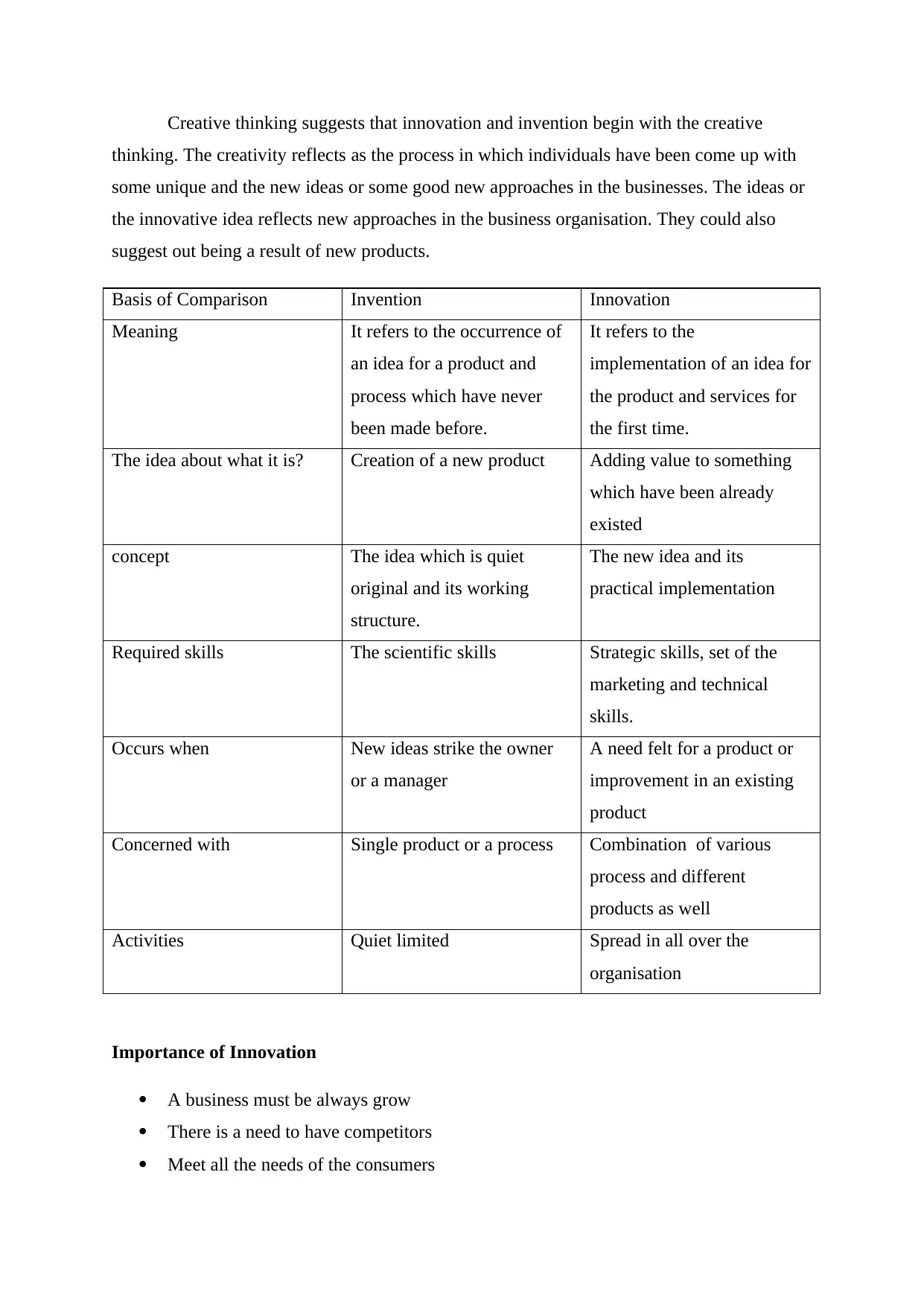
Creative thinking suggests that innovation and invention begin with the creative
thinking. The creativity reflects as the process in which individuals have been come up with
some unique and the new ideas or some good new approaches in the businesses. The ideas or
the innovative idea reflects new approaches in the business organisation. They could also
suggest out being a result of new products.
Basis of Comparison Invention Innovation
Meaning It refers to the occurrence of
an idea for a product and
process which have never
been made before.
It refers to the
implementation of an idea for
the product and services for
the first time.
The idea about what it is? Creation of a new product Adding value to something
which have been already
existed
concept The idea which is quiet
original and its working
structure.
The new idea and its
practical implementation
Required skills The scientific skills Strategic skills, set of the
marketing and technical
skills.
Occurs when New ideas strike the owner
or a manager
A need felt for a product or
improvement in an existing
product
Concerned with Single product or a process Combination of various
process and different
products as well
Activities Quiet limited Spread in all over the
organisation
Importance of Innovation
A business must be always grow
There is a need to have competitors
Meet all the needs of the consumers
thinking. The creativity reflects as the process in which individuals have been come up with
some unique and the new ideas or some good new approaches in the businesses. The ideas or
the innovative idea reflects new approaches in the business organisation. They could also
suggest out being a result of new products.
Basis of Comparison Invention Innovation
Meaning It refers to the occurrence of
an idea for a product and
process which have never
been made before.
It refers to the
implementation of an idea for
the product and services for
the first time.
The idea about what it is? Creation of a new product Adding value to something
which have been already
existed
concept The idea which is quiet
original and its working
structure.
The new idea and its
practical implementation
Required skills The scientific skills Strategic skills, set of the
marketing and technical
skills.
Occurs when New ideas strike the owner
or a manager
A need felt for a product or
improvement in an existing
product
Concerned with Single product or a process Combination of various
process and different
products as well
Activities Quiet limited Spread in all over the
organisation
Importance of Innovation
A business must be always grow
There is a need to have competitors
Meet all the needs of the consumers
Paraphrase This Document
Need a fresh take? Get an instant paraphrase of this document with our AI Paraphraser
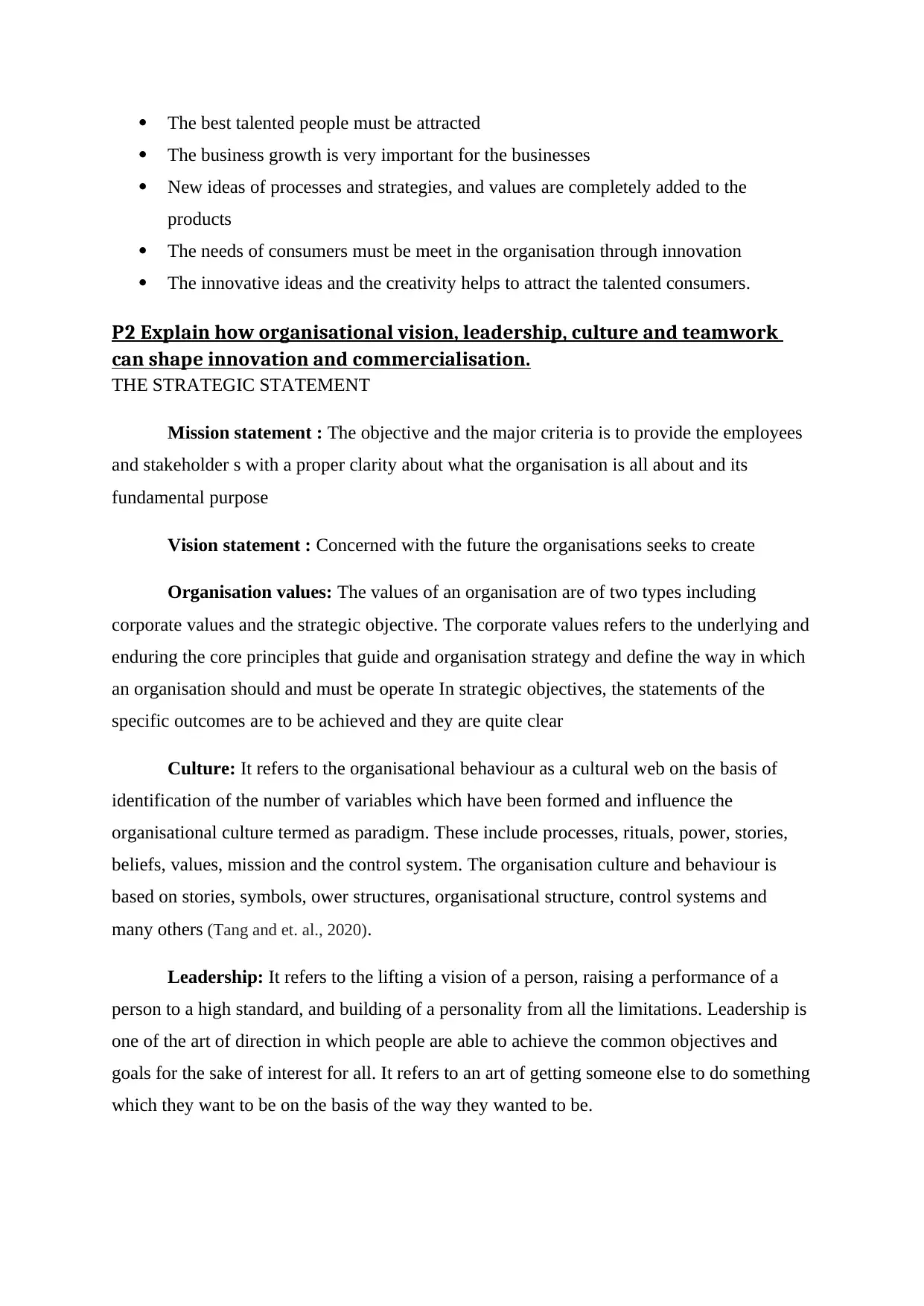
The best talented people must be attracted
The business growth is very important for the businesses
New ideas of processes and strategies, and values are completely added to the
products
The needs of consumers must be meet in the organisation through innovation
The innovative ideas and the creativity helps to attract the talented consumers.
P2 Explain how organisational vision, leadership, culture and teamwork
can shape innovation and commercialisation.
THE STRATEGIC STATEMENT
Mission statement : The objective and the major criteria is to provide the employees
and stakeholder s with a proper clarity about what the organisation is all about and its
fundamental purpose
Vision statement : Concerned with the future the organisations seeks to create
Organisation values: The values of an organisation are of two types including
corporate values and the strategic objective. The corporate values refers to the underlying and
enduring the core principles that guide and organisation strategy and define the way in which
an organisation should and must be operate In strategic objectives, the statements of the
specific outcomes are to be achieved and they are quite clear
Culture: It refers to the organisational behaviour as a cultural web on the basis of
identification of the number of variables which have been formed and influence the
organisational culture termed as paradigm. These include processes, rituals, power, stories,
beliefs, values, mission and the control system. The organisation culture and behaviour is
based on stories, symbols, ower structures, organisational structure, control systems and
many others (Tang and et. al., 2020).
Leadership: It refers to the lifting a vision of a person, raising a performance of a
person to a high standard, and building of a personality from all the limitations. Leadership is
one of the art of direction in which people are able to achieve the common objectives and
goals for the sake of interest for all. It refers to an art of getting someone else to do something
which they want to be on the basis of the way they wanted to be.
The business growth is very important for the businesses
New ideas of processes and strategies, and values are completely added to the
products
The needs of consumers must be meet in the organisation through innovation
The innovative ideas and the creativity helps to attract the talented consumers.
P2 Explain how organisational vision, leadership, culture and teamwork
can shape innovation and commercialisation.
THE STRATEGIC STATEMENT
Mission statement : The objective and the major criteria is to provide the employees
and stakeholder s with a proper clarity about what the organisation is all about and its
fundamental purpose
Vision statement : Concerned with the future the organisations seeks to create
Organisation values: The values of an organisation are of two types including
corporate values and the strategic objective. The corporate values refers to the underlying and
enduring the core principles that guide and organisation strategy and define the way in which
an organisation should and must be operate In strategic objectives, the statements of the
specific outcomes are to be achieved and they are quite clear
Culture: It refers to the organisational behaviour as a cultural web on the basis of
identification of the number of variables which have been formed and influence the
organisational culture termed as paradigm. These include processes, rituals, power, stories,
beliefs, values, mission and the control system. The organisation culture and behaviour is
based on stories, symbols, ower structures, organisational structure, control systems and
many others (Tang and et. al., 2020).
Leadership: It refers to the lifting a vision of a person, raising a performance of a
person to a high standard, and building of a personality from all the limitations. Leadership is
one of the art of direction in which people are able to achieve the common objectives and
goals for the sake of interest for all. It refers to an art of getting someone else to do something
which they want to be on the basis of the way they wanted to be.
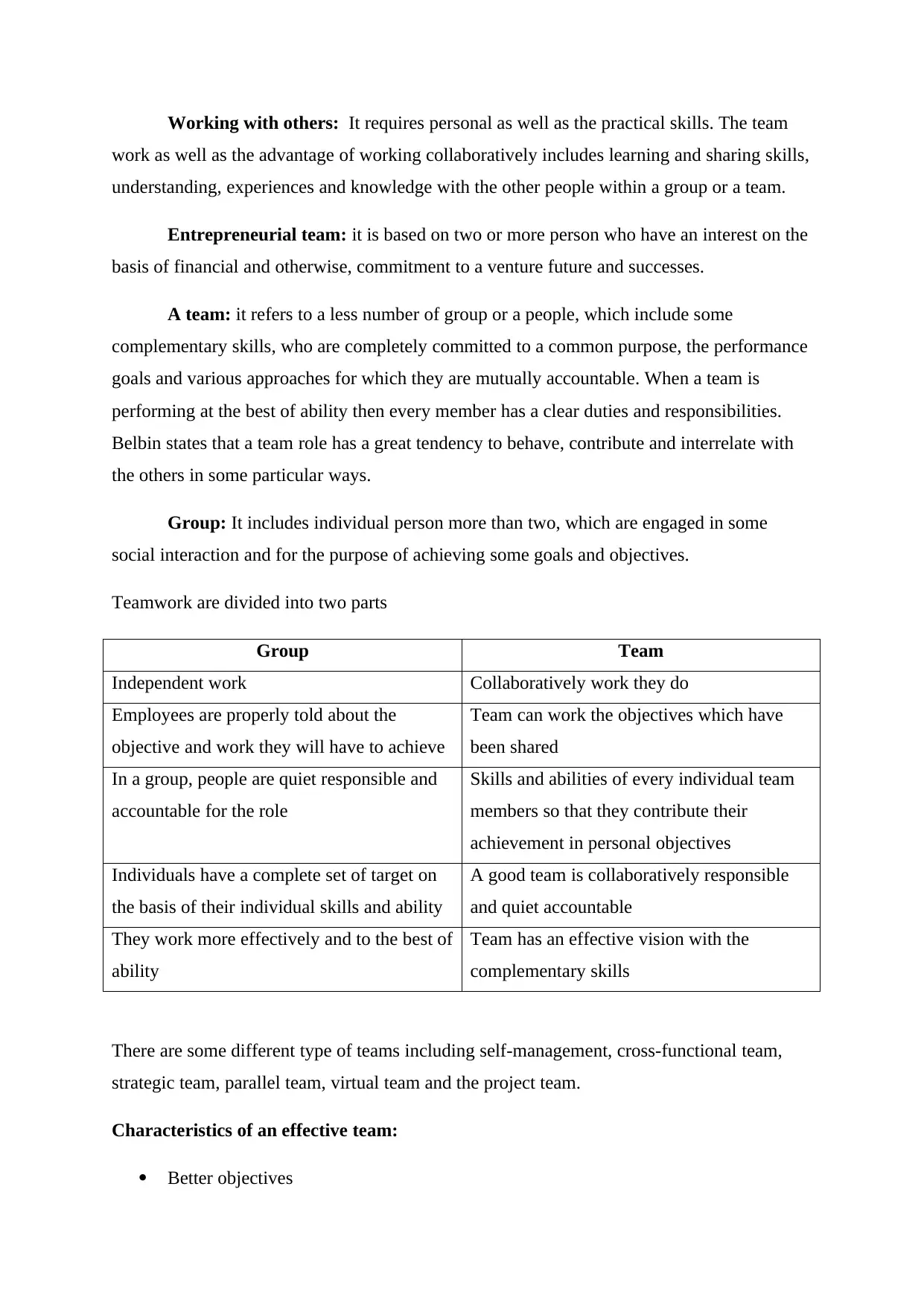
Working with others: It requires personal as well as the practical skills. The team
work as well as the advantage of working collaboratively includes learning and sharing skills,
understanding, experiences and knowledge with the other people within a group or a team.
Entrepreneurial team: it is based on two or more person who have an interest on the
basis of financial and otherwise, commitment to a venture future and successes.
A team: it refers to a less number of group or a people, which include some
complementary skills, who are completely committed to a common purpose, the performance
goals and various approaches for which they are mutually accountable. When a team is
performing at the best of ability then every member has a clear duties and responsibilities.
Belbin states that a team role has a great tendency to behave, contribute and interrelate with
the others in some particular ways.
Group: It includes individual person more than two, which are engaged in some
social interaction and for the purpose of achieving some goals and objectives.
Teamwork are divided into two parts
Group Team
Independent work Collaboratively work they do
Employees are properly told about the
objective and work they will have to achieve
Team can work the objectives which have
been shared
In a group, people are quiet responsible and
accountable for the role
Skills and abilities of every individual team
members so that they contribute their
achievement in personal objectives
Individuals have a complete set of target on
the basis of their individual skills and ability
A good team is collaboratively responsible
and quiet accountable
They work more effectively and to the best of
ability
Team has an effective vision with the
complementary skills
There are some different type of teams including self-management, cross-functional team,
strategic team, parallel team, virtual team and the project team.
Characteristics of an effective team:
Better objectives
work as well as the advantage of working collaboratively includes learning and sharing skills,
understanding, experiences and knowledge with the other people within a group or a team.
Entrepreneurial team: it is based on two or more person who have an interest on the
basis of financial and otherwise, commitment to a venture future and successes.
A team: it refers to a less number of group or a people, which include some
complementary skills, who are completely committed to a common purpose, the performance
goals and various approaches for which they are mutually accountable. When a team is
performing at the best of ability then every member has a clear duties and responsibilities.
Belbin states that a team role has a great tendency to behave, contribute and interrelate with
the others in some particular ways.
Group: It includes individual person more than two, which are engaged in some
social interaction and for the purpose of achieving some goals and objectives.
Teamwork are divided into two parts
Group Team
Independent work Collaboratively work they do
Employees are properly told about the
objective and work they will have to achieve
Team can work the objectives which have
been shared
In a group, people are quiet responsible and
accountable for the role
Skills and abilities of every individual team
members so that they contribute their
achievement in personal objectives
Individuals have a complete set of target on
the basis of their individual skills and ability
A good team is collaboratively responsible
and quiet accountable
They work more effectively and to the best of
ability
Team has an effective vision with the
complementary skills
There are some different type of teams including self-management, cross-functional team,
strategic team, parallel team, virtual team and the project team.
Characteristics of an effective team:
Better objectives
⊘ This is a preview!⊘
Do you want full access?
Subscribe today to unlock all pages.

Trusted by 1+ million students worldwide
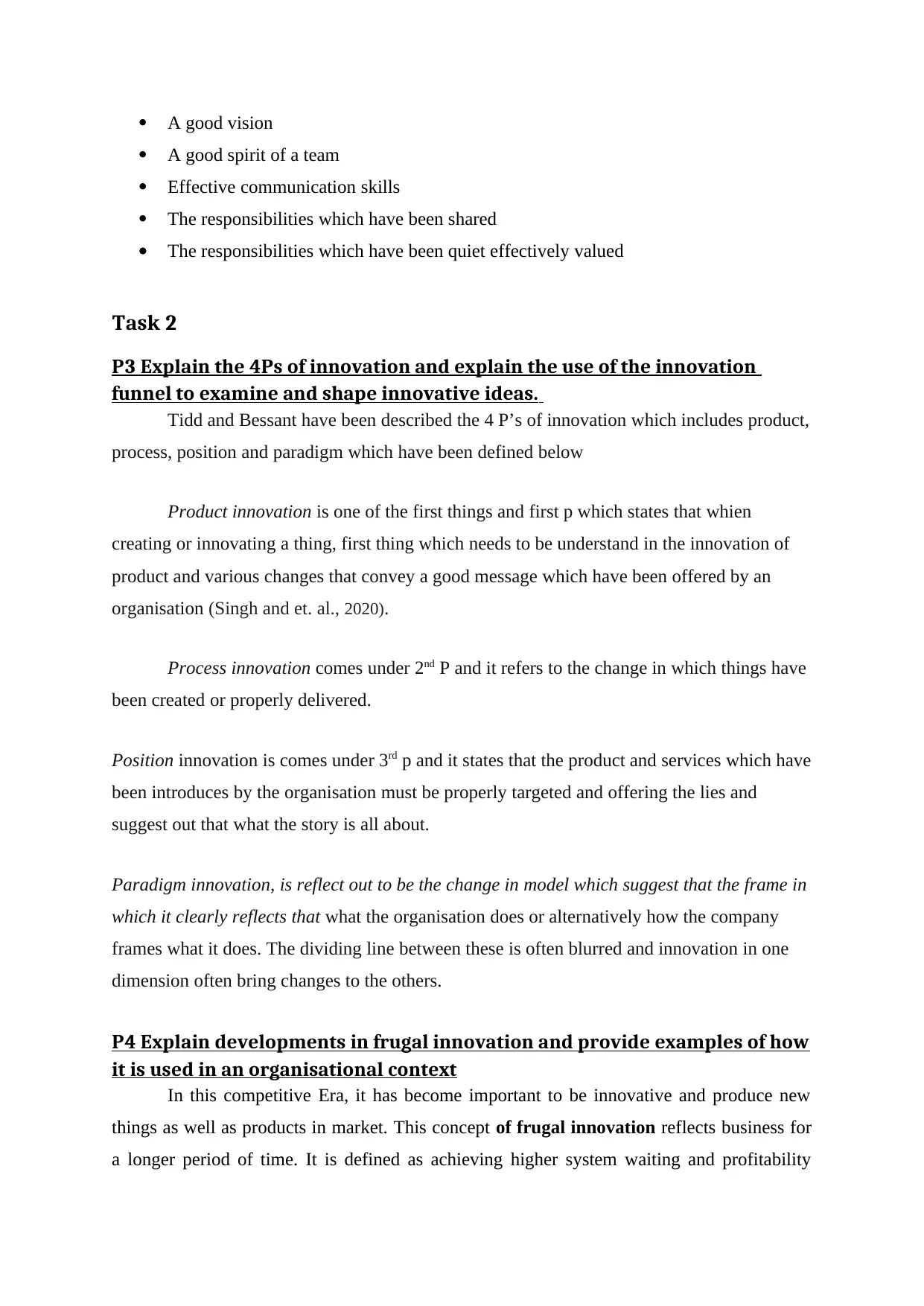
A good vision
A good spirit of a team
Effective communication skills
The responsibilities which have been shared
The responsibilities which have been quiet effectively valued
Task 2
P3 Explain the 4Ps of innovation and explain the use of the innovation
funnel to examine and shape innovative ideas.
Tidd and Bessant have been described the 4 P’s of innovation which includes product,
process, position and paradigm which have been defined below
Product innovation is one of the first things and first p which states that whien
creating or innovating a thing, first thing which needs to be understand in the innovation of
product and various changes that convey a good message which have been offered by an
organisation (Singh and et. al., 2020).
Process innovation comes under 2nd P and it refers to the change in which things have
been created or properly delivered.
Position innovation is comes under 3rd p and it states that the product and services which have
been introduces by the organisation must be properly targeted and offering the lies and
suggest out that what the story is all about.
Paradigm innovation, is reflect out to be the change in model which suggest that the frame in
which it clearly reflects that what the organisation does or alternatively how the company
frames what it does. The dividing line between these is often blurred and innovation in one
dimension often bring changes to the others.
P4 Explain developments in frugal innovation and provide examples of how
it is used in an organisational context
In this competitive Era, it has become important to be innovative and produce new
things as well as products in market. This concept of frugal innovation reflects business for
a longer period of time. It is defined as achieving higher system waiting and profitability
A good spirit of a team
Effective communication skills
The responsibilities which have been shared
The responsibilities which have been quiet effectively valued
Task 2
P3 Explain the 4Ps of innovation and explain the use of the innovation
funnel to examine and shape innovative ideas.
Tidd and Bessant have been described the 4 P’s of innovation which includes product,
process, position and paradigm which have been defined below
Product innovation is one of the first things and first p which states that whien
creating or innovating a thing, first thing which needs to be understand in the innovation of
product and various changes that convey a good message which have been offered by an
organisation (Singh and et. al., 2020).
Process innovation comes under 2nd P and it refers to the change in which things have
been created or properly delivered.
Position innovation is comes under 3rd p and it states that the product and services which have
been introduces by the organisation must be properly targeted and offering the lies and
suggest out that what the story is all about.
Paradigm innovation, is reflect out to be the change in model which suggest that the frame in
which it clearly reflects that what the organisation does or alternatively how the company
frames what it does. The dividing line between these is often blurred and innovation in one
dimension often bring changes to the others.
P4 Explain developments in frugal innovation and provide examples of how
it is used in an organisational context
In this competitive Era, it has become important to be innovative and produce new
things as well as products in market. This concept of frugal innovation reflects business for
a longer period of time. It is defined as achieving higher system waiting and profitability
Paraphrase This Document
Need a fresh take? Get an instant paraphrase of this document with our AI Paraphraser
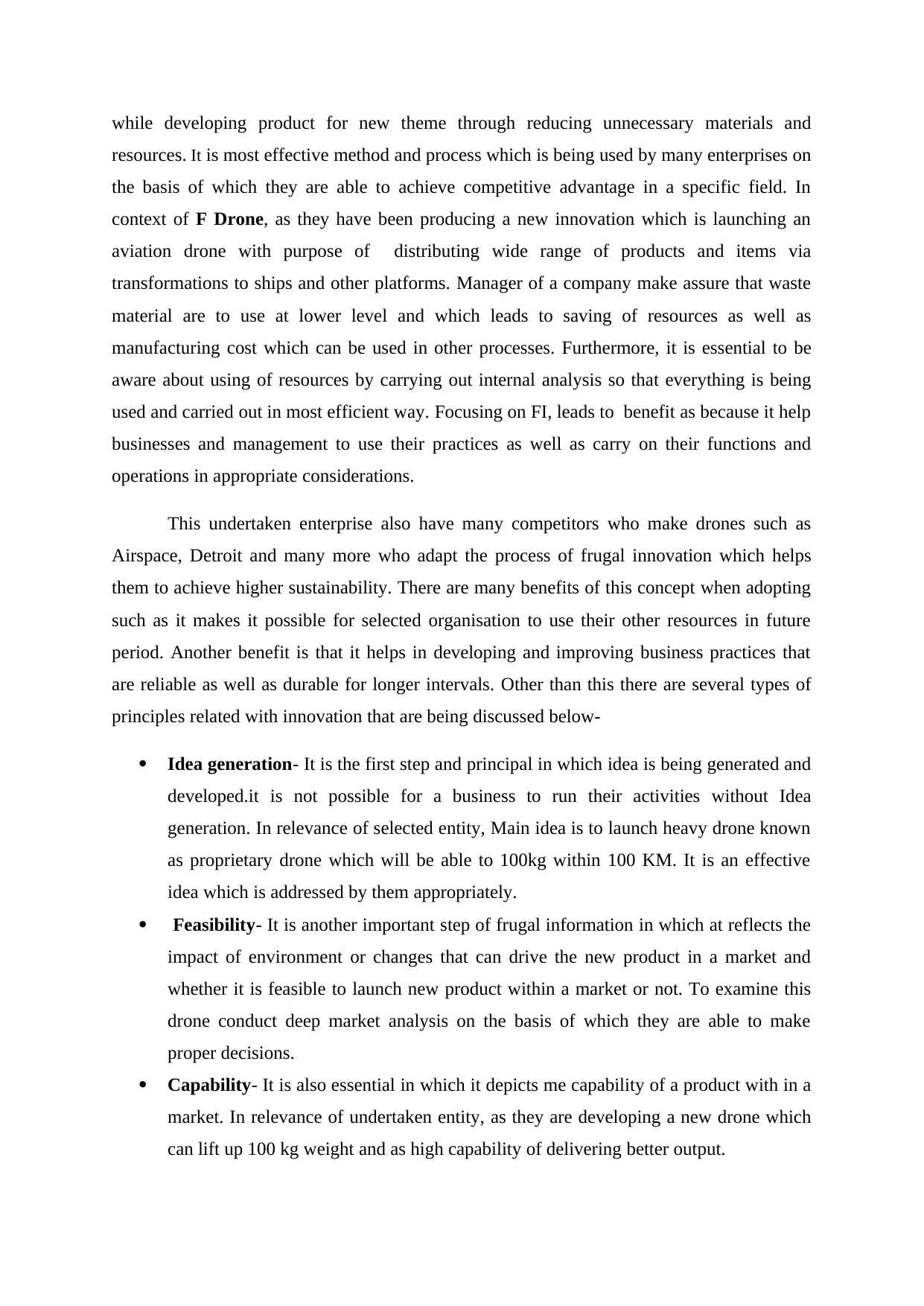
while developing product for new theme through reducing unnecessary materials and
resources. It is most effective method and process which is being used by many enterprises on
the basis of which they are able to achieve competitive advantage in a specific field. In
context of F Drone, as they have been producing a new innovation which is launching an
aviation drone with purpose of distributing wide range of products and items via
transformations to ships and other platforms. Manager of a company make assure that waste
material are to use at lower level and which leads to saving of resources as well as
manufacturing cost which can be used in other processes. Furthermore, it is essential to be
aware about using of resources by carrying out internal analysis so that everything is being
used and carried out in most efficient way. Focusing on FI, leads to benefit as because it help
businesses and management to use their practices as well as carry on their functions and
operations in appropriate considerations.
This undertaken enterprise also have many competitors who make drones such as
Airspace, Detroit and many more who adapt the process of frugal innovation which helps
them to achieve higher sustainability. There are many benefits of this concept when adopting
such as it makes it possible for selected organisation to use their other resources in future
period. Another benefit is that it helps in developing and improving business practices that
are reliable as well as durable for longer intervals. Other than this there are several types of
principles related with innovation that are being discussed below-
Idea generation- It is the first step and principal in which idea is being generated and
developed.it is not possible for a business to run their activities without Idea
generation. In relevance of selected entity, Main idea is to launch heavy drone known
as proprietary drone which will be able to 100kg within 100 KM. It is an effective
idea which is addressed by them appropriately.
Feasibility- It is another important step of frugal information in which at reflects the
impact of environment or changes that can drive the new product in a market and
whether it is feasible to launch new product within a market or not. To examine this
drone conduct deep market analysis on the basis of which they are able to make
proper decisions.
Capability- It is also essential in which it depicts me capability of a product with in a
market. In relevance of undertaken entity, as they are developing a new drone which
can lift up 100 kg weight and as high capability of delivering better output.
resources. It is most effective method and process which is being used by many enterprises on
the basis of which they are able to achieve competitive advantage in a specific field. In
context of F Drone, as they have been producing a new innovation which is launching an
aviation drone with purpose of distributing wide range of products and items via
transformations to ships and other platforms. Manager of a company make assure that waste
material are to use at lower level and which leads to saving of resources as well as
manufacturing cost which can be used in other processes. Furthermore, it is essential to be
aware about using of resources by carrying out internal analysis so that everything is being
used and carried out in most efficient way. Focusing on FI, leads to benefit as because it help
businesses and management to use their practices as well as carry on their functions and
operations in appropriate considerations.
This undertaken enterprise also have many competitors who make drones such as
Airspace, Detroit and many more who adapt the process of frugal innovation which helps
them to achieve higher sustainability. There are many benefits of this concept when adopting
such as it makes it possible for selected organisation to use their other resources in future
period. Another benefit is that it helps in developing and improving business practices that
are reliable as well as durable for longer intervals. Other than this there are several types of
principles related with innovation that are being discussed below-
Idea generation- It is the first step and principal in which idea is being generated and
developed.it is not possible for a business to run their activities without Idea
generation. In relevance of selected entity, Main idea is to launch heavy drone known
as proprietary drone which will be able to 100kg within 100 KM. It is an effective
idea which is addressed by them appropriately.
Feasibility- It is another important step of frugal information in which at reflects the
impact of environment or changes that can drive the new product in a market and
whether it is feasible to launch new product within a market or not. To examine this
drone conduct deep market analysis on the basis of which they are able to make
proper decisions.
Capability- It is also essential in which it depicts me capability of a product with in a
market. In relevance of undertaken entity, as they are developing a new drone which
can lift up 100 kg weight and as high capability of delivering better output.
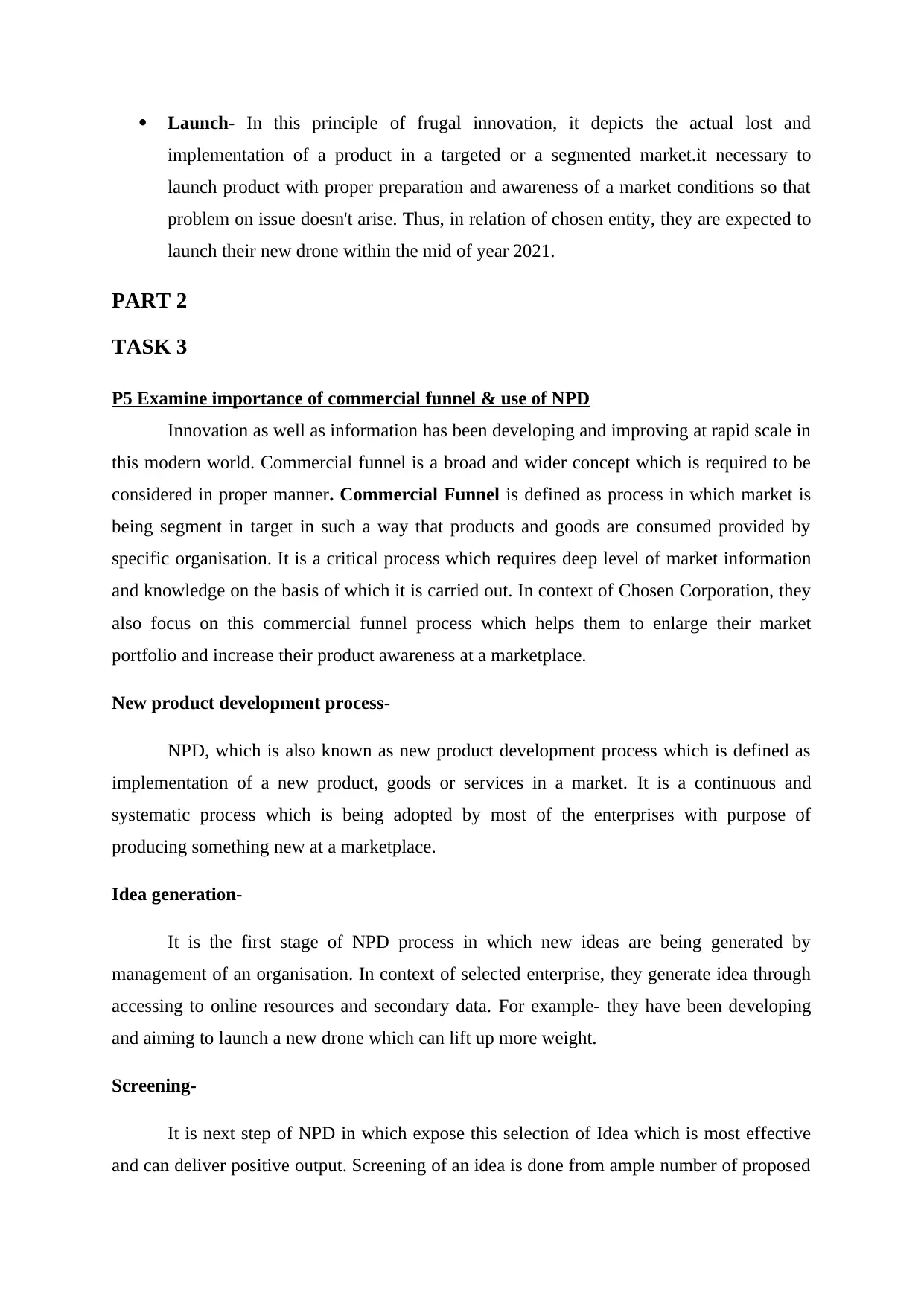
Launch- In this principle of frugal innovation, it depicts the actual lost and
implementation of a product in a targeted or a segmented market.it necessary to
launch product with proper preparation and awareness of a market conditions so that
problem on issue doesn't arise. Thus, in relation of chosen entity, they are expected to
launch their new drone within the mid of year 2021.
PART 2
TASK 3
P5 Examine importance of commercial funnel & use of NPD
Innovation as well as information has been developing and improving at rapid scale in
this modern world. Commercial funnel is a broad and wider concept which is required to be
considered in proper manner. Commercial Funnel is defined as process in which market is
being segment in target in such a way that products and goods are consumed provided by
specific organisation. It is a critical process which requires deep level of market information
and knowledge on the basis of which it is carried out. In context of Chosen Corporation, they
also focus on this commercial funnel process which helps them to enlarge their market
portfolio and increase their product awareness at a marketplace.
New product development process-
NPD, which is also known as new product development process which is defined as
implementation of a new product, goods or services in a market. It is a continuous and
systematic process which is being adopted by most of the enterprises with purpose of
producing something new at a marketplace.
Idea generation-
It is the first stage of NPD process in which new ideas are being generated by
management of an organisation. In context of selected enterprise, they generate idea through
accessing to online resources and secondary data. For example- they have been developing
and aiming to launch a new drone which can lift up more weight.
Screening-
It is next step of NPD in which expose this selection of Idea which is most effective
and can deliver positive output. Screening of an idea is done from ample number of proposed
implementation of a product in a targeted or a segmented market.it necessary to
launch product with proper preparation and awareness of a market conditions so that
problem on issue doesn't arise. Thus, in relation of chosen entity, they are expected to
launch their new drone within the mid of year 2021.
PART 2
TASK 3
P5 Examine importance of commercial funnel & use of NPD
Innovation as well as information has been developing and improving at rapid scale in
this modern world. Commercial funnel is a broad and wider concept which is required to be
considered in proper manner. Commercial Funnel is defined as process in which market is
being segment in target in such a way that products and goods are consumed provided by
specific organisation. It is a critical process which requires deep level of market information
and knowledge on the basis of which it is carried out. In context of Chosen Corporation, they
also focus on this commercial funnel process which helps them to enlarge their market
portfolio and increase their product awareness at a marketplace.
New product development process-
NPD, which is also known as new product development process which is defined as
implementation of a new product, goods or services in a market. It is a continuous and
systematic process which is being adopted by most of the enterprises with purpose of
producing something new at a marketplace.
Idea generation-
It is the first stage of NPD process in which new ideas are being generated by
management of an organisation. In context of selected enterprise, they generate idea through
accessing to online resources and secondary data. For example- they have been developing
and aiming to launch a new drone which can lift up more weight.
Screening-
It is next step of NPD in which expose this selection of Idea which is most effective
and can deliver positive output. Screening of an idea is done from ample number of proposed
⊘ This is a preview!⊘
Do you want full access?
Subscribe today to unlock all pages.

Trusted by 1+ million students worldwide
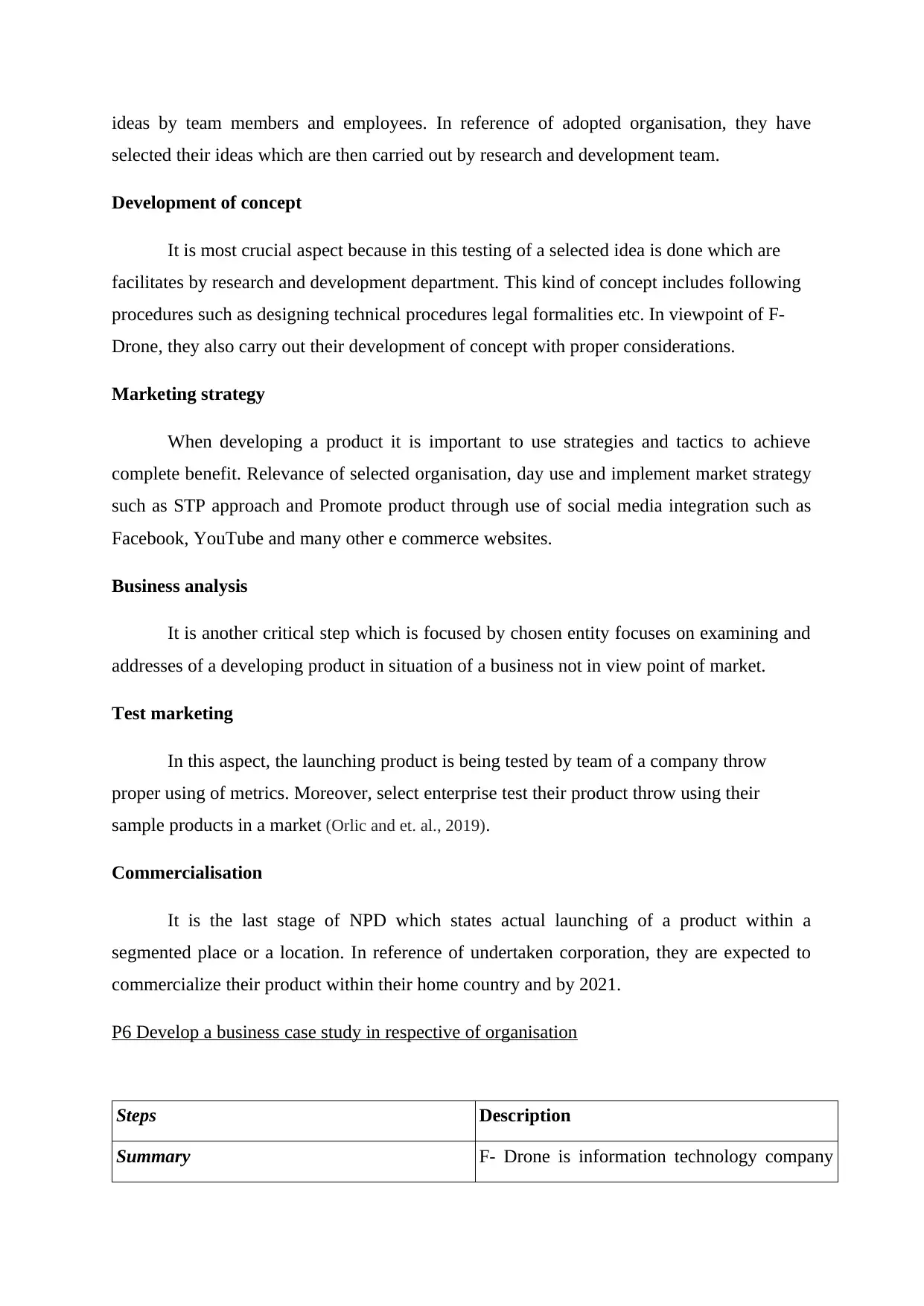
ideas by team members and employees. In reference of adopted organisation, they have
selected their ideas which are then carried out by research and development team.
Development of concept
It is most crucial aspect because in this testing of a selected idea is done which are
facilitates by research and development department. This kind of concept includes following
procedures such as designing technical procedures legal formalities etc. In viewpoint of F-
Drone, they also carry out their development of concept with proper considerations.
Marketing strategy
When developing a product it is important to use strategies and tactics to achieve
complete benefit. Relevance of selected organisation, day use and implement market strategy
such as STP approach and Promote product through use of social media integration such as
Facebook, YouTube and many other e commerce websites.
Business analysis
It is another critical step which is focused by chosen entity focuses on examining and
addresses of a developing product in situation of a business not in view point of market.
Test marketing
In this aspect, the launching product is being tested by team of a company throw
proper using of metrics. Moreover, select enterprise test their product throw using their
sample products in a market (Orlic and et. al., 2019).
Commercialisation
It is the last stage of NPD which states actual launching of a product within a
segmented place or a location. In reference of undertaken corporation, they are expected to
commercialize their product within their home country and by 2021.
P6 Develop a business case study in respective of organisation
Steps Description
Summary F- Drone is information technology company
selected their ideas which are then carried out by research and development team.
Development of concept
It is most crucial aspect because in this testing of a selected idea is done which are
facilitates by research and development department. This kind of concept includes following
procedures such as designing technical procedures legal formalities etc. In viewpoint of F-
Drone, they also carry out their development of concept with proper considerations.
Marketing strategy
When developing a product it is important to use strategies and tactics to achieve
complete benefit. Relevance of selected organisation, day use and implement market strategy
such as STP approach and Promote product through use of social media integration such as
Facebook, YouTube and many other e commerce websites.
Business analysis
It is another critical step which is focused by chosen entity focuses on examining and
addresses of a developing product in situation of a business not in view point of market.
Test marketing
In this aspect, the launching product is being tested by team of a company throw
proper using of metrics. Moreover, select enterprise test their product throw using their
sample products in a market (Orlic and et. al., 2019).
Commercialisation
It is the last stage of NPD which states actual launching of a product within a
segmented place or a location. In reference of undertaken corporation, they are expected to
commercialize their product within their home country and by 2021.
P6 Develop a business case study in respective of organisation
Steps Description
Summary F- Drone is information technology company
Paraphrase This Document
Need a fresh take? Get an instant paraphrase of this document with our AI Paraphraser
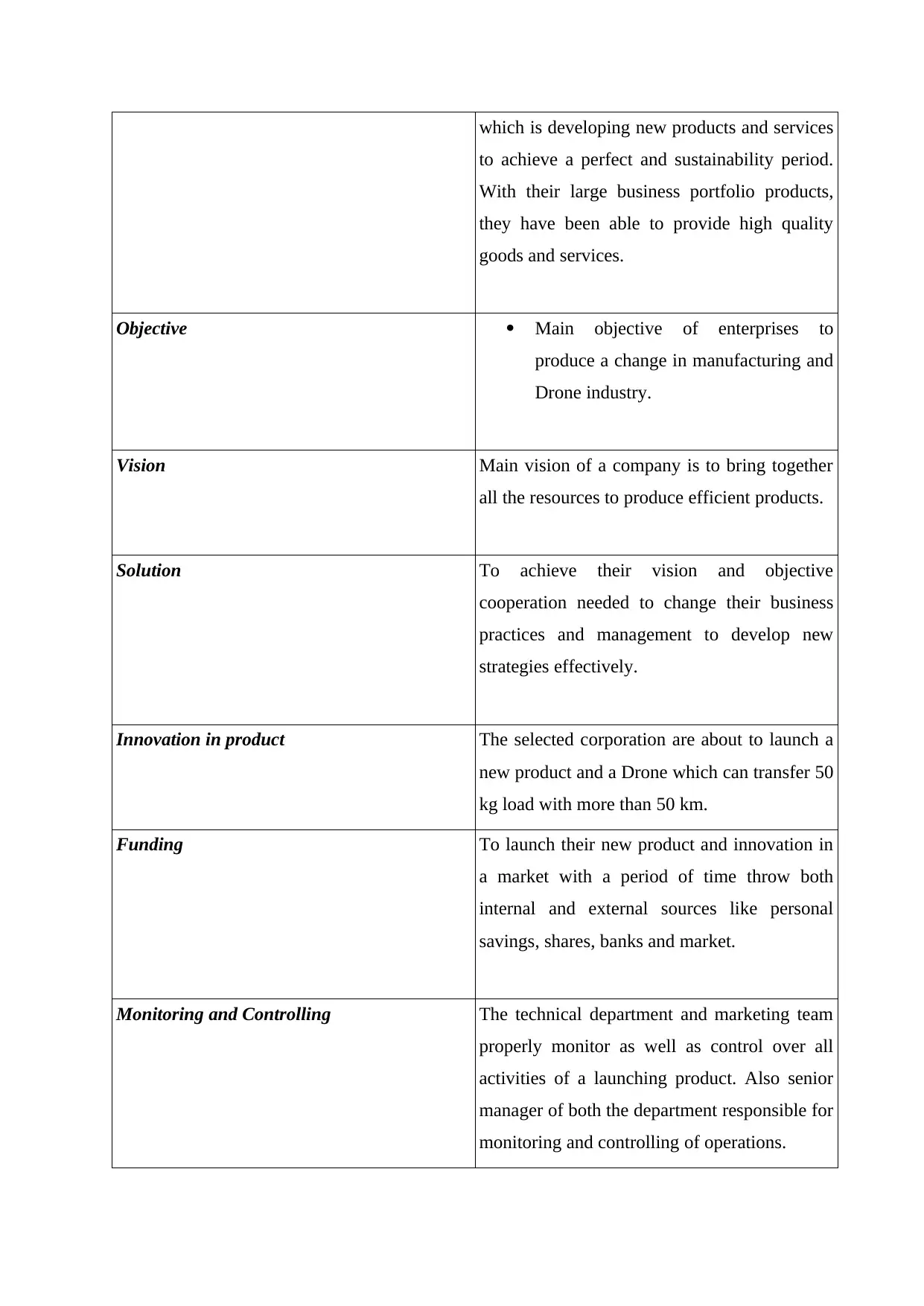
which is developing new products and services
to achieve a perfect and sustainability period.
With their large business portfolio products,
they have been able to provide high quality
goods and services.
Objective Main objective of enterprises to
produce a change in manufacturing and
Drone industry.
Vision Main vision of a company is to bring together
all the resources to produce efficient products.
Solution To achieve their vision and objective
cooperation needed to change their business
practices and management to develop new
strategies effectively.
Innovation in product The selected corporation are about to launch a
new product and a Drone which can transfer 50
kg load with more than 50 km.
Funding To launch their new product and innovation in
a market with a period of time throw both
internal and external sources like personal
savings, shares, banks and market.
Monitoring and Controlling The technical department and marketing team
properly monitor as well as control over all
activities of a launching product. Also senior
manager of both the department responsible for
monitoring and controlling of operations.
to achieve a perfect and sustainability period.
With their large business portfolio products,
they have been able to provide high quality
goods and services.
Objective Main objective of enterprises to
produce a change in manufacturing and
Drone industry.
Vision Main vision of a company is to bring together
all the resources to produce efficient products.
Solution To achieve their vision and objective
cooperation needed to change their business
practices and management to develop new
strategies effectively.
Innovation in product The selected corporation are about to launch a
new product and a Drone which can transfer 50
kg load with more than 50 km.
Funding To launch their new product and innovation in
a market with a period of time throw both
internal and external sources like personal
savings, shares, banks and market.
Monitoring and Controlling The technical department and marketing team
properly monitor as well as control over all
activities of a launching product. Also senior
manager of both the department responsible for
monitoring and controlling of operations.
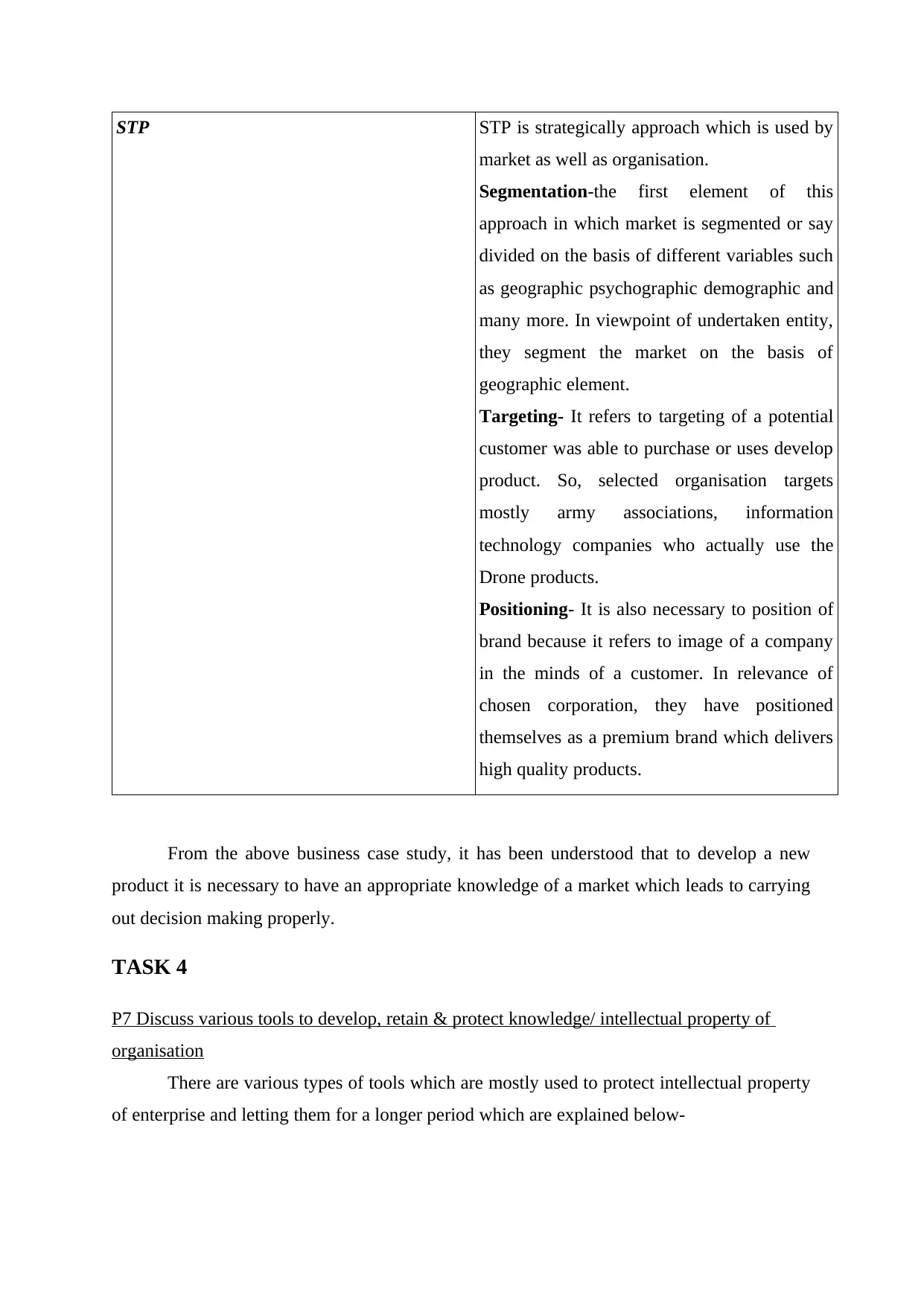
STP STP is strategically approach which is used by
market as well as organisation.
Segmentation-the first element of this
approach in which market is segmented or say
divided on the basis of different variables such
as geographic psychographic demographic and
many more. In viewpoint of undertaken entity,
they segment the market on the basis of
geographic element.
Targeting- It refers to targeting of a potential
customer was able to purchase or uses develop
product. So, selected organisation targets
mostly army associations, information
technology companies who actually use the
Drone products.
Positioning- It is also necessary to position of
brand because it refers to image of a company
in the minds of a customer. In relevance of
chosen corporation, they have positioned
themselves as a premium brand which delivers
high quality products.
From the above business case study, it has been understood that to develop a new
product it is necessary to have an appropriate knowledge of a market which leads to carrying
out decision making properly.
TASK 4
P7 Discuss various tools to develop, retain & protect knowledge/ intellectual property of
organisation
There are various types of tools which are mostly used to protect intellectual property
of enterprise and letting them for a longer period which are explained below-
market as well as organisation.
Segmentation-the first element of this
approach in which market is segmented or say
divided on the basis of different variables such
as geographic psychographic demographic and
many more. In viewpoint of undertaken entity,
they segment the market on the basis of
geographic element.
Targeting- It refers to targeting of a potential
customer was able to purchase or uses develop
product. So, selected organisation targets
mostly army associations, information
technology companies who actually use the
Drone products.
Positioning- It is also necessary to position of
brand because it refers to image of a company
in the minds of a customer. In relevance of
chosen corporation, they have positioned
themselves as a premium brand which delivers
high quality products.
From the above business case study, it has been understood that to develop a new
product it is necessary to have an appropriate knowledge of a market which leads to carrying
out decision making properly.
TASK 4
P7 Discuss various tools to develop, retain & protect knowledge/ intellectual property of
organisation
There are various types of tools which are mostly used to protect intellectual property
of enterprise and letting them for a longer period which are explained below-
⊘ This is a preview!⊘
Do you want full access?
Subscribe today to unlock all pages.

Trusted by 1+ million students worldwide
1 out of 17
Related Documents
Your All-in-One AI-Powered Toolkit for Academic Success.
+13062052269
info@desklib.com
Available 24*7 on WhatsApp / Email
![[object Object]](/_next/static/media/star-bottom.7253800d.svg)
Unlock your academic potential
Copyright © 2020–2026 A2Z Services. All Rights Reserved. Developed and managed by ZUCOL.





